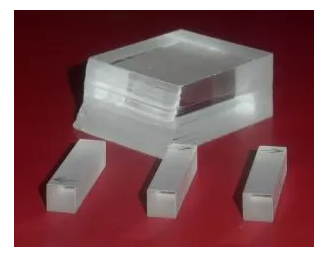定义
基于拉曼增益而不是受激发射的激光增益的激光器。
拉曼激光器是一种类似于普通激光器的光源,但其放大器介质基于拉曼增益(受激拉曼散射),而不是激发原子或离子的受激发射。这种类型的设备的主要吸引力在于,基本上任何拉曼激光波长都可以通过适当的泵浦波长选择来实现,前提是两个波长都在材料的透明区域内,并且达到足够高的非线性度和/或光学强度。
术语拉曼激光器有时也用于适用于拉曼光谱的激光器,但这不是本文的主题。
不同类型的拉曼激光器
拉曼活性介质通常是光纤或块状晶体,但有时也是气体。光纤中的长交互长度使其很容易超过阈值,尤其是在构建低损耗激光谐振器的情况下。然后,可以使用泵和输出功率通常在数百毫瓦到几瓦的泵和输出功率下进行连续波操作。在拉曼增益的光谱范围内,可以使用光纤布拉格光栅选择拉曼激光波长,这也导致发射带宽小,尽管由于非线性相互作用,单频操作难以实现。
级联拉曼光纤激光器可以使用嵌套的光纤布拉格光栅对构建。一个拉曼阶上的振荡用于泵浦另一个阶,因此可以桥接更大的频率偏移。例如,该技术可用于为掺铒光纤放大器制造1480 nm泵浦源,该放大器本身用1064 nm固态体激光器泵浦。

图1:未掺杂的KGW(钨酸钆钾)晶体,可用于拉曼激光器。照片由EKSMA OPTICS提供。
拉曼激光有时也用于固态体激光器。在这里,拉曼活性介质可以是放置在单独腔中的晶体(例如由硝酸钡、钨酸钆钾=KGW或人造金刚石制成),也可以是激光谐振腔内的附加拉曼晶体(腔内拉曼转换)。有时,甚至可以使用激光晶体本身(自拉曼转换),例如在掺镱的钨酸盐或钒酸盐晶体中作为拉曼活性介质。由于相互作用长度短(与光纤相比),只有几厘米,拉曼阈值很高,通常只能在Q开关操作中超过,脉冲持续时间在纳秒范围内。然而,使用优化的低损耗谐振器可以实现连续波操作[11]。甚至可以进行进一步的非线性频率转换,例如使用腔内倍频器[20]。然而,针对高输出功率优化此类器件并不容易,特别是由于激光晶体和拉曼晶体中的强热透镜。此外,对介电镜镀膜的要求可能不高,必须满足三个或更多波长的规格。
拉曼光纤激光器通常用稀土掺杂光纤激光器泵浦。然而,直接二极管泵浦也是可能的,因为已经有足够高亮度的半导体激光管可用[29]。
大多数拉曼光纤激光器基于普通二氧化硅光纤,并使用大约 13 THz 的拉曼频移。然而,人们可以使用其他材料,例如磷硅酸盐玻璃,以实现大约40 THz的更大拉曼频移或仅≈3 THz的非常小的频移[39]。后者导致非常小的量子缺陷和低热负荷。
基于芯片(硅激光器)上的硅(非二氧化硅)波导的拉曼激光器已被证明[9]。尽管相互作用长度短,但这种硅拉曼激光器是可能的,因为硅具有非常高的拉曼增益系数,并且使用的波导具有非常强的模式限制。有害影响可能是双光子吸收。请注意,硅拉曼激光器仍然需要外部泵浦激光器(硅很难实现),但可以达到比硅更长的波长。连续波拉曼激光器也已通过基于二氧化硅的环形微腔进行了演示[10]。
气体也可以用作拉曼增益介质。拉曼气体激光器通常具有高阈值泵浦功率,但通过使用高精细激光谐振器可以实现低阈值功率[4]。低阈值器件也由光子晶体光纤制成,其中小孔充满气体[22]。
由于拉曼放大仅在高强度下工作,因此其他非线性(如克尔效应或四波混合)在此类设备中也不可避免地很强。例如,这会使拉曼激光器难以获得窄线宽操作。
应用
拉曼激光器的应用示例包括:
- 光纤拉曼激光器,或更常见的拉曼光纤激光器级联,用于带内泵浦1480 nm左右的掺铒光纤放大器。对于拉曼移位步数较少的级联,使用磷酸硅酸盐纤维,表现出相当大的拉曼频移。
- 589-nm拉曼激光器可用于钠信标形式的激光导星,用于天文台的大气校正。
- 拉曼激光器可用作数字投影显示器的RGB源的一部分。
参考文献
[1] R. H. Stolen et al., “Raman oscillation in glass optical waveguide”, Appl. Phys. Lett. 20, 62 (1972), doi:10.1063/1.1654046
[2] E. O. Ammann and C. D. Decker, “0.9-W Raman oscillator”, J. Appl. Phys. 48 (5), 1973 (1977), doi:10.1063/1.323904
[3] H. A. Haus and M. Nakazawa, “Theory of the fiber Raman soliton laser”, J. Opt. Soc. Am. B 4 (5), 652 (1987), doi:10.1364/JOSAB.4.000652
[4] J. K. Brasseur et al., “Continuous-wave Raman laser in H2”, Opt. Lett. 23 (5), 367 (1998), doi:10.1364/OL.23.000367
[5] N. S. Kim et al., “1239/1484 nm cascaded phosphosilicate Raman fiber laser with CW output power of 1.36 W at 1484 nm pumped by CW Yb-doped double-clad fiber laser at 1064 nm and spectral continuum generation”, Opt. Commun. 176 (1-3), 219 (2000), doi:10.1016/S0030-4018(00)00525-3
[6] H. M. Pask, “The design and operation of solid-state Raman lasers”, Prog. Quantum Electron. 27 (1), 3 (2003), doi:10.1016/S0079-6727(02)00017-4
[7] H. M. Pask et al., “High average power, all-solid-state, external resonator Raman laser”, Opt. Lett. 28 (6), 435 (2003), doi:10.1364/OL.28.000435
[8] P. Cerny et al., “Solid state lasers with Raman frequency conversion”, Prog. Quantum Electron. 28 (2), 113 (2004), doi:10.1016/j.pquantelec.2003.09.003
[9] O. Boyraz and B. Jalali, “Demonstration of a silicon Raman laser”, Opt. Express 12 (21), 5269 (2004), doi:10.1364/OPEX.12.005269
[10] T. J. Kippenberg et al., “Ultralow-threshold microcavity Raman laser on a microelectronic chip”, Opt. Lett. 29 (11), 1224 (2004), doi:10.1364/OL.29.001224
[11] A. S. Grabitchov et al., “Multimode pumped continuous-wave solid-state Raman laser”, Opt. Lett. 29 (21), 2524 (2004), doi:10.1364/OL.29.002524 (first continuous-wave solid-state bulk Raman laser)
[12] R. P. Mildren et al., “Efficient, all-solid-state, Raman laser in the yellow, orange and red”, Opt. Express 12 (5), 785 (2004), doi:10.1364/OPEX.12.000785
[13] H. Rong et al., “A continuous-wave Raman silicon laser”, Nature 433, 725 (2005), doi:10.1038/nature03346
[14] R. P. Mildren et al., “Discretely tunable, all-solid-state laser in the green, yellow and red”, Opt. Lett. 30 (12), 1500 (2005), doi:10.1364/OL.30.001500
[15] H. M. Pask, “Continuous-wave, all-solid-state, intracavity Raman laser”, Opt. Lett. 30 (18), 2454 (2005), doi:10.1364/OL.30.002454
[16] B. Jalali et al., “Raman-based silicon photonics”, J. Sel. Top. Quantum Electron. (3), 412 (2006), doi:10.1109/JSTQE.2006.872708 (review paper, containing many useful references)
[17] C. A. Codemard et al., “High-power continuous-wave cladding-pumped Raman fiber laser”, Opt. Lett. 31 (15), 2290 (2006), doi:10.1364/OL.31.002290
[18] Z. Luo et al., “Stable and spacing-adjustable multiwavelength Raman fiber laser based on mixed- cascaded phosphosilicate fiber Raman linear cavity”, Opt. Lett. 33 (14), 1602 (2008), doi:10.1364/OL.33.001602
[19] H. Rong et al., “Low-threshold continuous-wave Raman silicon laser”, Nature Photon. 1 (4), 232 (2007), doi:10.1038/nphoton.2007.29
[20] P. Dekker et al., “All-solid-state 704 mW continuous-wave yellow source based on intracavity, frequency-doubled crystalline Raman laser”, Opt. Lett. 32 (9), 1114 (2007), doi:10.1364/OL.32.001114
[21] J. A. Piper and H. M. Pask, “Crystalline Raman Lasers”, J. Sel. Top. Quantum Electron. 13 (3), 692 (2007), doi:10.1109/JSTQE.2007.897175
[22] F. Couny et al., “Subwatt threshold cw Raman fiber-gas laser based on H2-filled hollow-core photonic crystal fiber”, Phys. Rev. Lett. 99 (14), 143903 (2007), doi:10.1103/PhysRevLett.99.143903
[23] H. Rong et al., “A cascaded silicon Raman laser”, Nature Photon. 2, 170 (2008), doi:10.1038/nphoton.2008.4
[24] A. J. Lee et al., “A wavelength-versatile, continuous-wave, self-Raman solid-state laser operating in the visible”, Opt. Express 18 (19), 20013 (2010), doi:10.1364/OE.18.020013
[25] A. Sabella et al., “1240 nm diamond Raman laser operating near the quantum limit”, Opt. Lett. 35 (23), 3874 (2010), doi:10.1364/OL.35.003874
[26] J. M. Feve et al., “High average power diamond Raman laser”, Opt. Express 19 (2), 913 (2011), doi:10.1364/OE.19.000913
[27] R. P. Mildren, “Side-pumped crystalline Raman laser”, Opt. Lett. 36 (2), 235 (2011), doi:10.1364/OL.36.000235
[28] O. Kitzler et al., “Continuous-wave wavelength conversion for high-power applications using an external cavity diamond Raman laser”, Opt. Lett. 37 (14), 2790 (2012), doi:10.1364/OL.37.002790
[29] S. I. Kablukov et al., “An LD-pumped Raman fiber laser operating below 1 μm”, Laser Phys. Lett. 10, 085103 (2013), doi:10.1088/1612-2011/10/8/085103
[30] M. Bernier et al., “Mid-infrared chalcogenide glass Raman fiber laser”, Opt. Lett. 38 (2), 127 (2013), doi:10.1364/OL.38.000127
[31] V. Fortin et al., “Modeling of As2S3 Raman fiber lasers operating in the mid-infrared”, IEEE Photonics Journal 5 (6), 1502309 (2013), doi:10.1109/JPHOT.2013.2287561
[32] M. Bernier et al., “3.77 μm fiber laser based on cascaded Raman gain in a chalcogenide glass fiber”, Opt. Lett. 39 (7), 2052 (2014), doi:10.1364/OL.39.002052
[33] T. Yao and J. Nilsson, “835 nm fiber Raman laser pulse pumped by a multimode laser diode at 806 nm”, J. Opt. Soc. Am. B 31 (4), 882 (2014), doi:10.1364/JOSAB.31.000882
[34] Q. Xiao et al., “Bidirectional pumped high power Raman fiber laser”, Opt. Express 24 (6), 6758 (2016), doi:10.1364/OE.24.006758
[35] J. Lin and D. J. Spence, “25.5 fs dissipative soliton diamond Raman laser”, Opt. Lett. 41 (8), 1861 (2016), doi:10.1364/OL.41.001861
[36] Y. Shamir et al., “250 W clad pumped Raman all-fiber laser with brightness enhancement”, Opt. Lett. 43 (4), 711 (2018), doi:10.1364/OL.43.000711
[37] Y. C. Liu et al., “Compact efficient high-power triple-color Nd:YVO4 yellow-lime-green self-Raman lasers”, Opt. Lett. 45 (5), 1144 (2020), doi:10.1364/OL.388266
[38] A. Grimes A. Hariharan and J. W. Nicholson, “Progress on high power Raman fiber lasers at 1.48 and 1.7 μm”, Proc. SPIE 11665, 116650P (2021), doi:10.1117/12.2583068
[39] X. Ma et al., “Hundred-watt-level phosphosilicate Raman fiber laser with less than 1% quantum defect”, Opt. Lett. 46 (11), 2662 (2021), doi:10.1364/OL.426752
[40] C. Fan et al., “Kilowatt level Raman amplifier based on 100 μm core diameter multimode GRIN fiber with M2 = 1.6”, Opt. Lett. 46 (14), 3432 (2021), doi:10.1364/OL.431273



